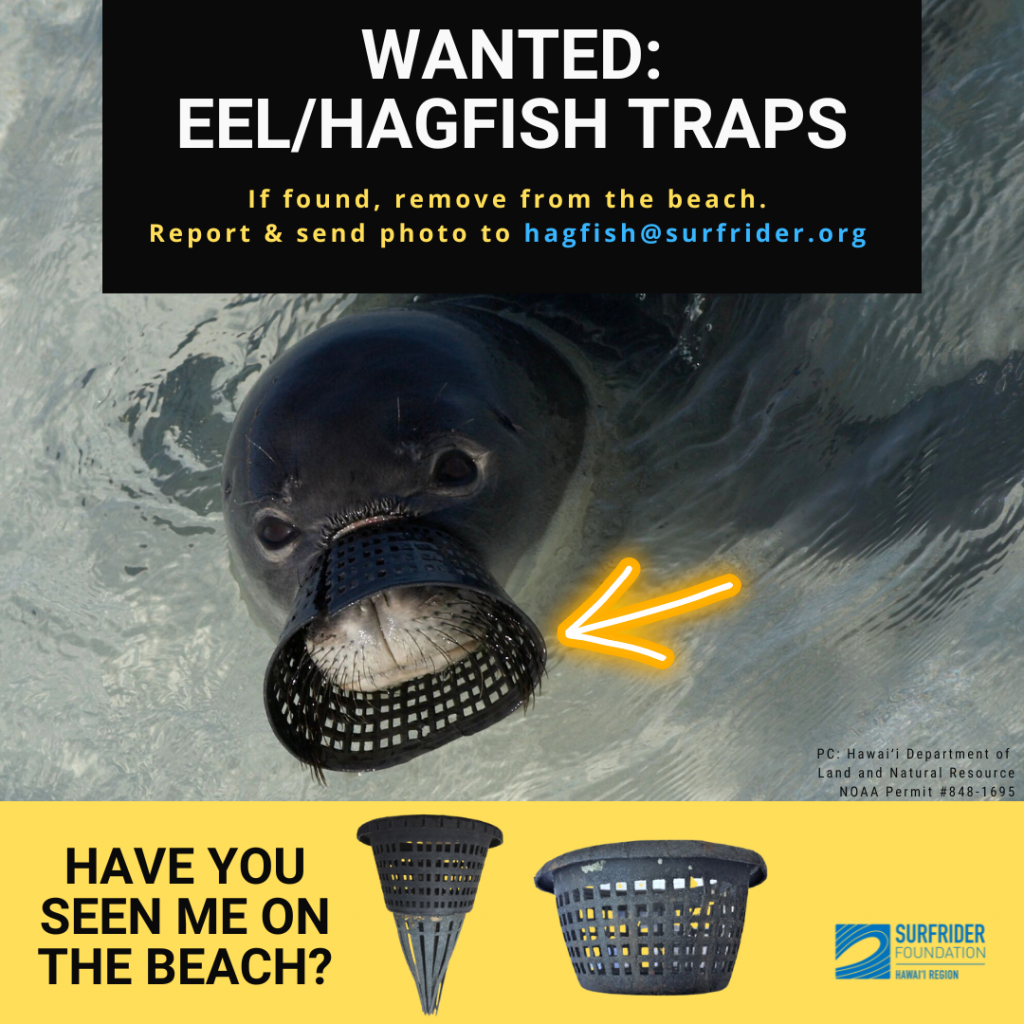
The North Pacific Eel Trap Project is an international, collaborative effort to develop options aimed at reducing the number of lost and discarded hagfish traps and thus their impact on Hawaiian Monk Seals. It may also serve as a replicable model for future efforts aimed at derelict fishing gear reduction.

The Problem
Lost and discarded fishing gear is a primary contributor to plastic pollution on Hawaiʻi beaches and poses a major threat to marine and coastal ecosystems. Yet given its international scope, large geographical range, and difficulties in tracing the source of gear, derelict fishing gear remains a challenging problem.
Eel and hagfish traps represent one of the many types of commercial fishing gear that pollute Hawaiʻi coastlines. Compared to other types of fishing gear, however, the eel trap’s distinctive cone shaped funnels are easily identifiable and originate from conger eel fisheries in the East China Sea as well as small hagfish fisheries on the west coast of North America. Conger eels are consumed for food across Asia. The hagfish are sold almost exclusively to Korean markets for food or use in “eel skin” products such as wallets and boots.
Since launching the North Pacific Eel Trap project in 2020, Surfrider Foundation and partner organizations from across Hawaiʻi have collected and removed over 10,000 traps from shorelines in both the main Hawaiian islands and the Northwest Hawaiian Islands.
The Solution
The North Pacific Eel Trap Project is a collaborative effort to develop options aimed at reducing lost and discarded hagfish traps and thus their impact on Hawaiian Monk Seals. It may also serve as a replicable model for future efforts aimed at derelict fishing gear reduction.
The project's primary goals are:
- Identify the source (producers and users) of eel/hagfish traps washing up on Hawaiʻi coastlines.
- Catalog the different models of eel/hagfish traps collected (which will further help with source identification)
- Minimize the number of traps that harm, or are ingested by, marine mammals (particularly Hawaiian monk seals) by removing as many traps as possible from shorelines
- Collaborate with conger eel and hagfish fisheries on options to reduce the number of lost or discarded traps
- Develop a program for the collection and recording of data from eel traps collected along the shores of the west coast of North America, Korea, Taiwan, China, and Japan
- Support the development of alternatives to plastic eel traps, including biodegradable traps or trap exchange programs.
Get Involved
Surfrider Foundation is encouraging beach cleanup organizations and individuals to get involved by:
1. Removing any eel/hagfish traps you find on the beach.
2. Keeping the traps and contacting hagfish@surfrider.org. Include a picture of each trap and the number of traps collected.
Information about where to send hagfish traps will be provided via email.
Project & Data Updates (2023)
Since 2020, Surfrider Foundation and its partners (SHARKastics, Hawaiʻi Wildlife Fund, and more) have helped achieve the following:
- Removed over 10,000 eel/hagfish traps from Hawaiʻi coastlines
- Developed a digital catalog of 926 traps to help sort and identify different trap models.
- Developed a trap model characterization scheme based on trap diameter, number of holes, distinct markings/writing, etc.
- From the trap catalog and characterization scheme, determined that there are 137 distinct models of eel/hagfish traps. The 10 most frequently found models account for ~50% of the traps photographed and the top 20 most frequently found models account for 68% of the traps photographed.
- Attended and presented at the 7th International Marine Debris Conference in Busan, South Korea to share project information and develop partnerships with Asia-based NGOʻs, scientists, and fisheries.
Click here to learn more >

